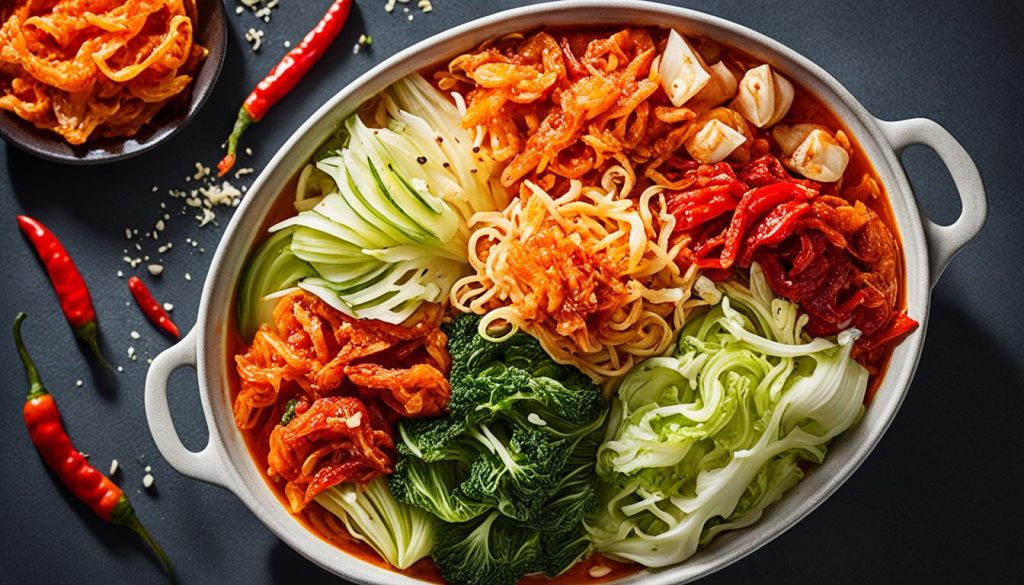Curious about the taste of kimchi? Wondering about its flavor profile? In this article, we’ll take a deep dive into the world of kimchi and explore its unique taste experience.
Kimchi is a traditional Korean side dish made from fermented vegetables and spices. Its taste is rich, complex, and unlike anything you’ve ever tried before. So, what exactly does kimchi taste like?
When you take your first bite of kimchi, you’ll be greeted with a satisfying crunch from the fermented vegetables. As you continue to chew, a burst of umami flavor unfolds, followed by a delightful combination of sourness, spiciness, and tanginess. It’s a harmonious blend of flavors that dances on your taste buds.
The fermentation process is what gives kimchi its distinct flavor. As the vegetables ferment, they develop additional flavors over time, making each batch of kimchi unique. This versatility allows kimchi to cater to different palates and dietary needs, with endless variations available.
So, if you’re ready to embark on a kimchi flavor adventure, continue reading to discover more about this beloved Korean dish and its tantalizing taste profile.
What Is Kimchi?
Kimchi is a traditional Korean side dish that has been a staple of Korean cuisine for centuries. It is a type of fermented vegetable dish that offers a unique and flavorful taste experience. The most common version of kimchi is made with napa cabbage as the main ingredient, but it can also be made with other vegetables such as radishes or cucumbers. The process of making kimchi involves fermenting the vegetables with spices to develop its distinct flavor profile.
There are countless variations of kimchi, each with its own combination of ingredients and flavors. However, some of the common ingredients used in kimchi include garlic, ginger, green onion, and Korean red chili powder called gochugaru. These ingredients contribute to the tanginess, spiciness, and umami flavors that are characteristic of kimchi.
Here is a table showcasing some popular variations of kimchi:
| Variation | Main Ingredient | Flavor Profile |
|---|---|---|
| Baechu Kimchi | Napa Cabbage | Sweet, Tangy, Spicy |
| Kkakdugi | Radish | Salty, Spicy |
| Oi Sobagi | Cucumber | Refreshing, Spicy |
Kimchi is not only a delicious side dish but also offers several health benefits. It is rich in vitamins, minerals, and fiber and contains beneficial probiotics that support gut health. The fermentation process also enhances the bioavailability of nutrients in the vegetables, making them easier to digest and absorb.
What Does Kimchi Taste Like?
Kimchi has a rich and complex taste that is difficult to describe in a single word. It offers a combination of different flavors that work together to create a unique and vibrant taste experience.
The initial crunch of the vegetables gives way to a burst of umami, followed by the sourness, spiciness, and tanginess of the dish. The sourness comes from the fermentation process, while the spiciness is from the Korean red chili powder. The umami flavors in kimchi come from the combination of ingredients such as garlic, ginger, and fish sauce.
The taste of kimchi evolves over time as it continues to ferment, with the flavors becoming more intense and complex. The umami flavors deepen, while the sourness and spiciness develop further. This complexity is what makes kimchi so intriguing and enjoyable.
Overall, kimchi is a dish that offers a delightful balance of flavors that are both bold and harmonious. The combination of sourness, spiciness, umami, and tanginess creates a taste sensation that is truly unique to kimchi.
Examples of Kimchi Flavor Profile:
| Flavor | Description |
|---|---|
| Sourness | The fermentation process gives kimchi a distinct sour taste that adds a tangy element to the dish. |
| Spiciness | Korean red chili powder, known as gochugaru, brings a fiery kick to kimchi and adds a spicy flavor to balance the other tastes. |
| Umami | Kimchi is packed with umami flavors from ingredients like garlic, ginger, and fish sauce, creating a savory and complex taste. |
| Complexity | The combination of different flavors in kimchi creates a complex taste profile that evolves and deepens over time. |

How Is Kimchi Made?
Kimchi is made through a process called lacto-fermentation. This traditional Korean method of fermentation involves brining the vegetables in salt, which draws out moisture and creates a brine. The brine serves two purposes: it kills harmful bacteria and creates an environment that allows beneficial lactobacillus bacteria to thrive and begin the fermentation process.
Once the vegetables are brined, they are coated with a paste made from a combination of flavorful seasonings. Common ingredients used in kimchi seasoning include ginger, garlic, gochugaru (Korean red chili powder), and fish sauce. This paste enhances the taste of the vegetables and adds complexity to the final product.
Next, the seasoned vegetables and the paste are packed tightly into a jar or container for fermentation. It is crucial to seal the container tightly to prevent the entry of unwanted bacteria during the fermentation process.
During fermentation, the lactobacillus bacteria convert sugars present in the vegetables into lactic acid. This lactic acid gives kimchi its distinctive tangy flavor and acts as a natural preservative, helping to preserve the vegetables for an extended period.
The length of fermentation can vary, but typically, kimchi is left to ferment for a few days at room temperature to kickstart the fermentation process. After this initial fermentation period, it is transferred to the refrigerator for slower fermentation, which allows the flavors to continue to develop and intensify.
Proper storage is essential to maintain the flavor and quality of kimchi. The fermented dish should be stored in an airtight container in the refrigerator to prevent spoilage. This ensures that the kimchi stays fresh and delicious for an extended period.
Kimchi preparation steps:
- Brine the vegetables in salt to draw out moisture and create a brine.
- Coat the vegetables with a paste made from seasonings like ginger, garlic, gochugaru, and fish sauce.
- Pack the seasoned vegetables tightly into a jar or container for fermentation.
- Seal the container tightly to prevent the entry of unwanted bacteria.
- Allow the kimchi to ferment at room temperature for a few days, then transfer it to the refrigerator for slower fermentation.
- Store the kimchi in an airtight container in the refrigerator to maintain its flavor and quality.
| Key Kimchi Preparation Steps | Description |
|---|---|
| Brining | Salt draws out moisture, creating a brine that kills harmful bacteria and enables beneficial lactobacillus bacteria to thrive. |
| Seasoning | A paste made from ginger, garlic, gochugaru, and fish sauce is applied to the vegetables, enhancing their flavor. |
| Fermentation | The seasoned vegetables are packed into a jar or container and tightly sealed for fermentation. Lactobacillus bacteria convert sugars into lactic acid, imparting tanginess and preserving the vegetables. |
| Storage | Kimchi should be stored in an airtight container in the refrigerator to maintain its flavor and prevent spoilage. |
Now that you know how kimchi is made, you can try your hand at preparing this flavorful and versatile Korean dish at home. Enjoy the process of fermentation and savor the delicious results of your homemade kimchi!
Conclusion
Kimchi is more than just a delicious staple in Korean cuisine. It is a culinary exploration that offers a symphony of flavors, combining the sourness, saltiness, spiciness, and umami in every bite. From its roots as a traditional fermented side dish, kimchi has evolved to become a versatile ingredient that can enhance a wide range of recipes, ensuring you never get bored.
Embracing kimchi flavors opens up a world of culinary possibilities. Its complex taste profile can add depth and excitement to soups, stir-fries, rice dishes, and even sandwiches. The versatility of kimchi means you can experiment, mix, and match to create your own unique taste experiences.
Not only is kimchi a taste sensation, but it also offers numerous health benefits. This beloved dish is packed with probiotics that support healthy digestion, essential vitamins and minerals, and potential weight management advantages. Incorporating kimchi into your diet can help promote overall well-being and a healthy gut.
While you can easily find kimchi in grocery stores, there is something special about making your own homemade kimchi. This allows you to tailor the flavors to your preferences and enjoy the process of creating this beloved dish. Whether you’re a kimchi connoisseur or just starting your kimchi journey, the nutritional value and culinary joy it brings make it worth exploring and incorporating into your meals.







